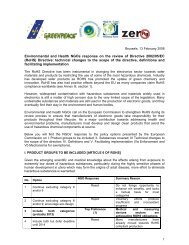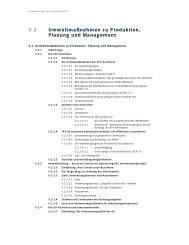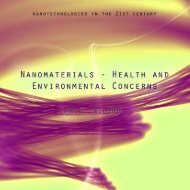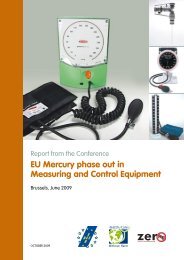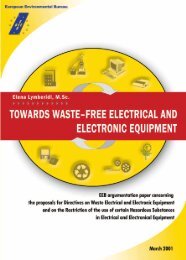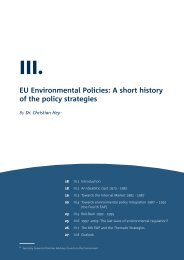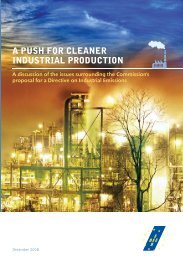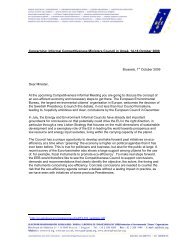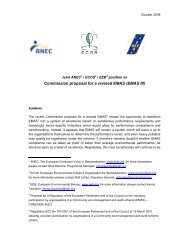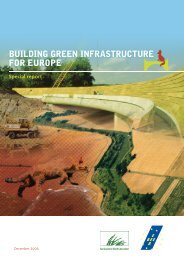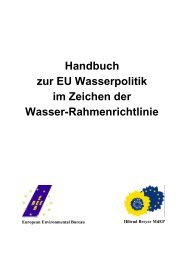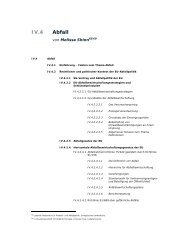Memorandum to Czech Presidency and Ten Test - EEB
Memorandum to Czech Presidency and Ten Test - EEB
Memorandum to Czech Presidency and Ten Test - EEB
- No tags were found...
Create successful ePaper yourself
Turn your PDF publications into a flip-book with our unique Google optimized e-Paper software.
<strong>EEB</strong> <strong>Memor<strong>and</strong>um</strong> <strong>to</strong> the <strong>Czech</strong> EU <strong>Presidency</strong>7.4. Implement a Coherent Framework for Industrial Pollution Prevention<strong>and</strong> Control, Including The Review of The IPPC DirectiveThe Commission proposal for a recast of Directive 96/61/EC on IntegratedPollution Prevention <strong>and</strong> Control (IPPC) was published on 21 December 2007.The critical role of the recast in filling existing gaps in the current IPPC Directive<strong>and</strong> the fierce controversy surrounding the proposal dem<strong>and</strong> firm leadership fromthe <strong>Presidency</strong> on a number of key issues.First, in order <strong>to</strong> protect key safety nets in the IPPC Directive, it is vital for allac<strong>to</strong>rs <strong>to</strong> respect the constraints of the recasting technique. This implies thatwhen developing a Common Position on IPPC, the <strong>Presidency</strong> must ensure thatCouncil’s amendments are restricted <strong>to</strong> those provisions opened in theCommission’s proposal.The Commission proposal will integrate six sec<strong>to</strong>ral directives under theproposed IPPC recast, including the Directives on Waste Incineration, LargeCombustion Plants, Solvent Emissions, <strong>and</strong> three Directives on Titanium Dioxide.These sec<strong>to</strong>ral directives include m<strong>and</strong>a<strong>to</strong>ry Emission Limit Values (ELVs) thatensure that relevant installations do not emit above a certain threshold. <strong>EEB</strong>considers it critical that these ELVs are not eroded but rather that they aretightened <strong>to</strong> reflect the lowest emission levels achievable through the applicationof BAT.<strong>EEB</strong> believes that in order <strong>to</strong> ensure a level playing field, competent authoritiesmust be legally obliged <strong>to</strong> refer <strong>to</strong> the BAT listed in the BAT ReferenceDocuments (BREF) <strong>and</strong> impose permit conditions that reflect emission limitvalues associated with the BAT. BAT reflects a dynamic concept <strong>and</strong> as such theBREFs are reviewed approximately every six years. Permit conditions must alsobe reviewed in a timely manner as BAT evolves <strong>and</strong> better environmentalperformance becomes fully feasible. In the <strong>Czech</strong> Republic the obligation is <strong>to</strong>update every 8 years.IPPC affects about 50,000 industrial installations in the EU <strong>and</strong> was due <strong>to</strong> befully implemented by 30 Oc<strong>to</strong>ber 2007. However, several Member States havefailed <strong>to</strong> achieve full implementation, with up <strong>to</strong> 50% of IPPC installations in someMember States operating under permits from preceding legislation. It is criticalthat the Commission is supported in its efforts <strong>to</strong> increase the capacity ofcompetent authorities <strong>to</strong> deliver IPPC permits <strong>and</strong> perform appropriateinspections, in order <strong>to</strong> address this implementation deficit. The strengthening ofthe dynamic BAT concept of IPPC striving for continuous improvements ofenvironmental performance for the industrial sec<strong>to</strong>r needs <strong>to</strong> be supported. Early<strong>and</strong> active involvement from different Member States with ambitious objectives <strong>to</strong>prevent pollution from industrial activities can considerably speed up the29



